Pickups for DIY Guitar Kits
If there is a component of an electric guitar that generates more excitement and discussion than any other it has to be the pickups.
And not without good reason. Unlike an acoustic guitar which produces sound holistically, when it comes to the electric guitar, aside from the skill and feel of the guitarist, the pickups are by far the most expressive component in regard to tone with everything else playing more or less a secondary role.
In this guide, we’re going to take a closer look at pickups. But rather than focus on brands or analyze the pickups specific players use, we’re going to explain (in simple terms) how pickups work and the main types of pickups used on the majority of DIY kit guitars, including the pros and cons of each.
So, if you have been wondering how pickups really work, and the differences between the types available, don’t fret it, this article is for you.
How Pickups Produce Sound
There’s something magical about electric guitar pickups, at least that’s what I always felt when I was growing up learning guitar.
Pickups don’t draw electricity from a wall socket, yet when plugged into an audio cable that is plugged into an amplifier sound is produced.
So how does this work?
What kind of voodoo enables electric guitar pickups to generate an electrical signal?
It’s not the audio cable, in case you’re wondering.
While it’s true, XLR cables can carry a small amount of electricity (48V) to a condenser microphone, referred to as phantom power, guitars (with the exception of some acoustic/electric guitars) do not use XLR inputs and standard instrument cables are incapable of transporting sufficient voltage.
The real secret to how pickups produce an electrical signal can be found in the branch of physics known as electromagnetism. Don’t worry, while the word itself sounds complicated, the concept itself is fairly simple.
The Components of a Guitar Pickup
Pickups are transducers.
Transducers are devices that measure energy in one form and convert it to another. Transducers are literally everywhere in modern society. For example, a solar roof system is a transducer. It takes energy from the sun and converts it to electricity.
To understand how this applies to pickups, we first need to take a closer look at the components of a guitar pickup.
 The image above shows a single coil electric guitar pickup. The main components are:
The image above shows a single coil electric guitar pickup. The main components are:
- The base magnet and magnetized pole pieces
- Copper wire coil surrounding the magnet, held in place by a bobbin.
Recommended: Copper Shielding Your Guitar's Pickup Cavity
Steel guitar strings are ferromagnetic. This means if the string is in proximity to a magnet, that section of the string becomes magnetized, creating its own magnetic field.
This means the strings must have a steel component. If playing a guitar with nylon strings e.g. a classical or flamenco guitar, the transducer utilises another form of energy, Piezoelectricity.
In truth, the magnet and individual pole pieces (there are usually one (or more) for each string) primary job is to magnetize the string. When the magnetized string is then vibrated over the copper coil, a signal is recorded in response to the change to the magnetic field.
The more coils or winding of copper a pickup is surrounded by, the higher the voltage, which produces a more powerful signal especially within the mid range frequencies.
This essentially means the characteristics of the frequency (rate of vibration) of the vibrating guitar string can represent components of sound such as pitch, amplitude (volume), and rate of decay e.g. sustain.
This is essentially Faraday’s law of induction in a nutshell, which explains how a magnetic field that is subject to change can generate an electric current.
Additionally, the pots on your guitar e.g. volume and tone pots are used to control and shape the signal being generated. For example, the volume pot when turned anti-clockwise affects the amount of signal sent to ground instead of to the amplifier which in turn reduces volume.
What are Piezo Pickups?
Piezo pickups are just another type of transducer, relying on the concept of Piezoelectric (detecting changes in pressure), rather than electromagnetism which detects changes in a magnetic field. They are generally installed beneath the bridge, and utilize crystals to detect changes in pressure caused by the vibration of the strings. This type of pickup is mostly associated with acoustic instruments, although are also seen in some high-end bass guitars often accompanying a magnetic pickup.
Active vs. Passive Pickups
You may have heard the term active pickups. These are the pickups you might see on guitars associated with hard rock and metal that do not visibly expose the individual magnetic pole pieces, and instead are often covered.
Most pickups are passive. This is especially the case for DIY electric guitar kits.
This means they do not utilize an electrical source and rely only on the concept of electromagnetism as outlined above. However, active pickups utilize electricity provided by a 9V battery (the square batteries used in effects pedals) which is generally located within the rear cavity of the guitar.
The reason an active pickup utilizes a power source is to boost the initial signal, resulting in higher output which produces a louder signal and a more consistent tone.
Condenser microphones operate in a similar way, however as previously mentioned they draw their power directly through an XLR cable, if phantom power is not provided the microphone will not detect sound.
Left and Right-hand Pickups
If you are left-handed, like me, you may have wondered if left-handed guitars require left-handed pickups or if there is any such thing as right or left-handed pickups?
For the most part, pickups are pickups, there’s really not a lot of difference in construction between pickups for either left or right-handed guitars with one exception.
Staggered and flat pole pickups
The image below shows a single coil staggered pickup. As you can see the individual magnetic pole pieces are set at different heights.

Staggered pickups address volume imbalances created by the arc of the fretboard. This is also why the saddles (the independent components in the guitar’s bridge) on a typical SSS style guitar can be adjusted for height to maintain consistency across the fretboard.
However, when it comes to the guitar’s pickups, as the fretboard is not completely flat, as is the case with the top plate of the guitar’s pickups, the strings that are closer to the middle of neck are slightly further away from their designated magnetic pole piece.
Raising the height of the pole pieces closer to the middle of the neck helps balance the volume more evenly across strings. Additional compensation is given to the wound strings (the thicker 4th, 5th and 6th strings) as the additional mass of the strings, all things being equal, produces less output than the unwound 1st and 2nd strings.
The difference staggered pickups really make to the average guitar are debatable. Many guitarists won't perceive any noticeable difference in volume between strings, if using standard pickups on a left-handed guitar or flat pole pickups. Jimi Hendrix for one, used a right-handed guitar upside down, meaning the strings were flipped but not the pickups. However, in an attempt to emulate Hendrix’s tone some guitarists have reverse staggered the pole pieces in their single coil pickups.
If you are left-handed or want to try staggered pickups, left and right-handed pickups and pickup sets are available after-market or it is also possible to adjust the individual pole pieces manually, although this is not recommended unless you know what you are doing.
Pickups for 6 and 7 string guitars
Guitars that utilize 7 (or more) strings have specific requirements with regard to pickup design. This is also generally the case for 4 and 5 string bass guitars.
While 7 string guitars typically do not utilize single coil pickups. Using a standard 6 string humbucker on a 7 string guitar, even if capable of filling the pickup cavity, would be unable to provide an even distribution of volume across the 7 strings as some strings may be directly above a pole piece while others will be located a little further away resulting in an unbalanced sound across the neck.
But that’s not the only consideration.
7 string guitars, due to the 7th string being tuned all the way down to B also utilize a wider frequency range than 6 string guitars. While there are exceptions, this, combined with the more aggressive styles of music associated with 7 string guitars often means active humbuckers due to the boosted signal and enhanced articulation, as opposed to passive pickups, are a better option for 7 string guitars.
Types of Pickups
Phew. Now that we have covered the technical side of pickups we can take a closer look at how different pickup designs affect tone. While there are variations of each there really are three main types of pickup seen on DIY electric guitar kits, single coil pickups, humbuckers and P90 pickups.
We’ll start by looking at, arguably the most common, the single coil pickup.
Single Coil Pickups
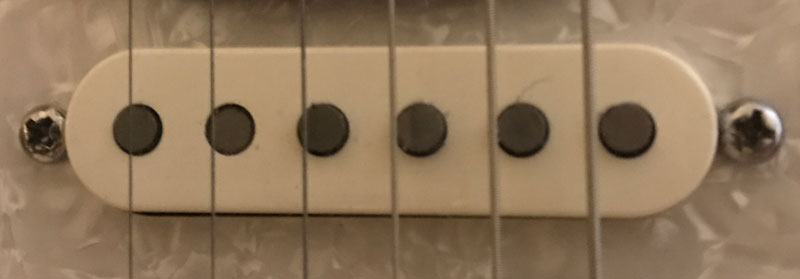
Single coil pickups, as the name implies, utilize a single magnet. This type of pickup is most commonly associated with the Fender Stratocaster© and guitars heavily influenced by the design of the Strat©.
DIY kits with single coil pickups:
In general single coil pickups produce a bright, expressive tone, and as a result are often seen in genres such as country and blues, typified by artists such as Stevie Ray Vaughan, Eric Clapton and John Mayer.
The downside to single coil pickups is they are less capable of handling high output, unlike humbuckers, making them less suitable for heavier styles of music. They are also more prone to electrical interference in the 50 - 60Hz range, from components such as light fittings.
Pickup Combinations
Single coil pickups are usually seen as sets of three, including a bridge, middle position and neck pickup. This configuration is known as SSS, with the S referring to the pickup being a single coil and is commonly associated with the Fender Stratocaster©.
Other combinations include HSS and HSH. The H refers to humbucker pickups which we will discuss in more detail in the next section.

HSS and HSH pickup combinations are mostly associated with Superstrats© which are essentially Stratocaster© influenced designs from brands such as Ibanez©, Washburn©, and Jackson© (among many others) that include a humbucker in the bridge position and/or neck position for additional gain.
This type of guitar was popular with 80s hard rock and metal bands such as Bon Jovi, Iron Maiden, Skid Row, and guitarists such as Steve Vai (formerly of Whitesnake), Nuno Bettencourt (Extreme), and Kirk Hammet (Metallica).
The Pickup Selector Switch
Different sounds can be extracted from the pickups on your guitar based on the position of the pickup selector switch, usually located on the bottom half of the guitar, embedded on the guitar’s pickguard (if your guitar has one) beneath the tone and volume controls.
The pickup selector switch is usually a 3 or 5 position blade switch and allows the guitarist to isolate pickups or use them in combination depending on how the guitar is wired.
For example, since changing from a three position switch in the late 70s the Fender Stratocaster© features a 5 position pickup selector. This means the bridge, middle and neck pickups can be used independently, based on the position of the switch, along with being used in different combinations.
If the selector switch is in position 1 (the switch is pushed all the way to the front) the neck pickup is engaged only. In position two, the neck and middle pickup are engaged. In position three the middle pickup is independent. In position 4 the bridge and middle pickups are used in combination and position five engages the bridge pickup only.
While there isn’t a position that engages all pickups at once, each position results in a different tone being produced based on which pickups are engaged.
Bridge, Middle and Neck Pickup Design and Tone
While one might assume that there isn’t a tangible difference between single coil bridge, middle and neck pickups with regard to pickup design (after all they look much the same), the opposite is true.
This is evident when purchasing aftermarket pickups or replacing an individual pickup as in the case of single coil pickups you will need to select either bridge, middle or neck position when looking at available options.
Each pickup position offers a different tonality which guitarists rely on for creating different sounds based on the style of music they are playing or role within a band e.g. rhythm guitar or lead guitar.
This is due to the position of the pickup on the guitar’s body, in relation to the guitar’s strings ability to vibrate and the design of the pickup based on these factors.
For example, if you consider a guitar string suspended between the bridge of the guitar and its tuners, the string will require less energy to vibrate if closer to the middle of the string due to there being less tension on that particular section of string, being further from a fixed point.
For example the bridge pickup will generally a brighter sound, cutting through a mix more easily as tension on the strings is higher at the bridge position. However, this additional tension reduces the amplitude (volume) able to be produced by the string and detected by the pickup so bridge pickups are usually designed for higher output.
The neck pickup, being adjacent to a section of the guitar’s string under less tension typically sounds warmer as a result of additional bass frequencies being present. It also produces more volume as a result, meaning the pickup can be designed for slightly lower output.
The middle pickup generally falls somewhere between the two, offering more crunch and brightness than the neck pickup, making it ideal for crunchy rhythm playing but lacking the warmth one might associate with more of a bluesier tone, although this can be subjective.
Pickup Polarity
Another important consideration with regard to pick up design in relation to pickup combinations is pickup polarity, which refers to the direction of the pickup's magnetic field.
The magnetic pole pieces inside the pickups can be north or south facing (this can easily be determined by holding a compass against the pickup if needing to replace a single pickup) and the direction the copper coil surrounding the pickup bobbin is wound e.g. clockwise or anti-clockwise.
In the case of an SSS guitar, the neck and bridge pickups share the same magnetic orientation e.g. they both may be north or south facing and share the same direction of copper wire coil.
As discussed above, both pickups cannot be played in combination meaning any combination of neck and middle pickup, or bridge and middle pickup will be out of phase and as a result less prone to electrical interference, resulting in noise projected through the amp the guitar is plugged into.
Humbucker Pickups
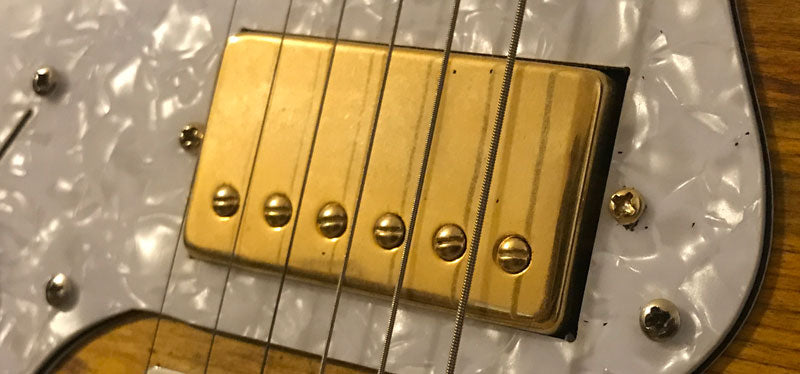
Humbuckers, or humbucking pickups are less susceptible to the ‘hum’ of electrical interference, as indicated by the name ‘hum - bucker’.
DIY kits with humbucking pickups:
- E35 style guitar kits
- LP-style guitar kits
- EXP-style guitar kits
- SG-style guitar kits
- FB-style guitar kits
- PR-style guitar kits
Humbuckers literally buck the hum caused by electrical interference by utilizing two independent magnets with one being wound in reverse. This reverses the polarity and cancels out any interference a single coil pickup would otherwise be subject to in much the same way sets of single coil pickups utilize different magnetic orientation to reduce electrical interference.

Because of this, humbuckers are capable of higher output and as a result are more suitable for hard rock and metal and similar heavier styles of music.
Mini Humbuckers
A less common type of humbucker, mostly seen in Firebird© style guitar kits, and some archtop kits, are mini-humbuckers. At a comparable size to P90 pickups, most mini-humbuckers and P90 pickups are interchangeable as the pickup cavities are the same size.
Much like P90 pickups mini-humbuckers are often thought of as a compromise between single coil and full size humbuckers, however due to the reverse polarity are less prone to electrical interference than single coil and P90’s.
As mini-humbuckers are smaller in diameter, less mass is added by the copper coils providing less overall voltage and a brighter though less powerful signal than a standard humbucker.
This unique characteristic makes them more suitable to Jazz and styles that lean more heavily on note articulation and rely on cleaner tones.
P90 Pickups
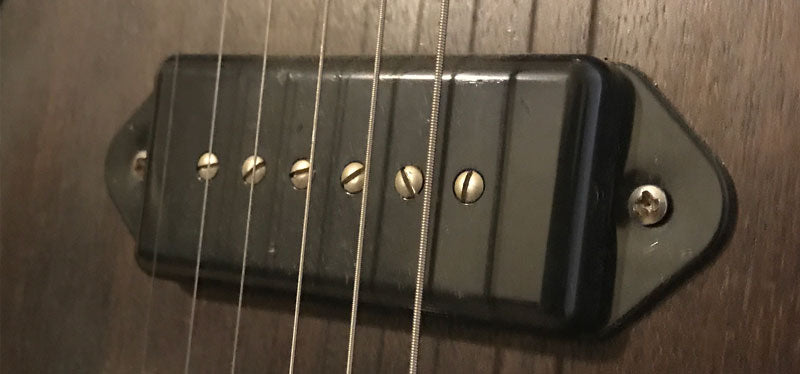
P90 pickups are less common than single coil and humbuckers, especially amongst DIY Kit Guitars. You will mostly see P90 pickups on models such as the LPJ.
P90 pickups typically utilize a wider, shallower bobbin which results in a greater mass of copper wire surrounding the pickup’s magnetized parts. This increase in mass produces a warmer tone, more in keeping with a humbucker pickup. This is why P90 pickups are less genre specific.
However the additional wire makes P90 pickups more susceptible to electrical interference and resulting noise. This is perhaps why P90 pickups, out of all genres are mostly associated with punk rock, which as a genre is less concerned, and in some cases actually embraces noise.
Bass Guitar Pickups
While bass guitars (and some electric guitars for that matter) occasionally utilize Piezo pickups, in the majority of cases DIY bass guitar kits use passive magnetic pickups and therefore do not require an external power source such as a battery.
Magnetic pickups, regardless of whether they are found in an electric guitar or bass guitar utilize the same principles to produce sound, detecting a change in the magnetic field established by the interplay between the pickup and steel guitar strings and then measuring this change which is then used to determine the characteristics of the sound waves produced including frequency (pitch) and amplitude (volume).
Depending on the particular bass guitar the pickup is installed on they may utilize more or less magnetic pole pieces, or use thicker gauge wire coils for the lower frequencies the bass guitar produces, but all things being equal rely on the same principles to produce and shape the tonal characteristics of the instrument.
Single Coil, Split Coil and Humbuckers
Bass guitar pickups, much like electric guitars can be categorized as either humbuckers or single coils, and offer the same pros and cons as electric guitar pickups with single coils being more prone to electrical interference but having the advantage of sounding a touch brighter. Alternatively, humbuckers often sound warmer and are less susceptible to electrical interference.
Unlike the electric guitar however, bass guitar pickups also come in split coil (offset humbucker) configuration. While sold as a single unit, this type of configuration is made up of two individually wound single coil pickups utilizing the same concept as humbuckers as the individual coils are wired in the opposite direction to the opposing pickup, reversing the polarity and therefore canceling out hum caused by electrical interference.
Why Bass Guitars Use Additional Magnets
Another difference between electric guitar and bass guitar pickups is the magnetic pole piece configuration, specifically the number of pole pieces. Initially all bass pickups came with a single magnetic pole piece for each string much like electric guitars.
However over time two magnetic pole pieces were introduced for each string, at least in some models such as the Precision Bass© to address the problem bass pickups had handling transients (the short attack of sound typically produced when a sound is generated) and the additional vibrational movement produced as bass strings tend to vibrate more than electric guitar strings due to their additional mass.
Rail style pickups (pickups that utilize a single blade of steel as opposed to individual magnetic pole pieces) also address this issue.
Types of Bass Guitar Pickups
J Style Pickups
J style pickups, named after Fender’s Jazz Bass© guitar are typically long, narrow single coil pickups and generally sit higher on the guitar than P style pickups.

They are known for their distinctive bright tone and as a result are ideal for jazz where note articulation is considered more of a priority than a thick, warm tone.
As per the image above they typically feature two alnico magnetic pole pieces for each string but, while less common, may also use a ‘rail’ spanning the entire width of the pickup.
You will find this type of pickup on the JB bass guitar kit.
P Style Pickups
P style pickups differ from J style pickups in that they are split coil pickups. They take their name from the Fender Precision Bass© which features a split coil pickup in the bridge position and are seen on the W bass guitar kit.
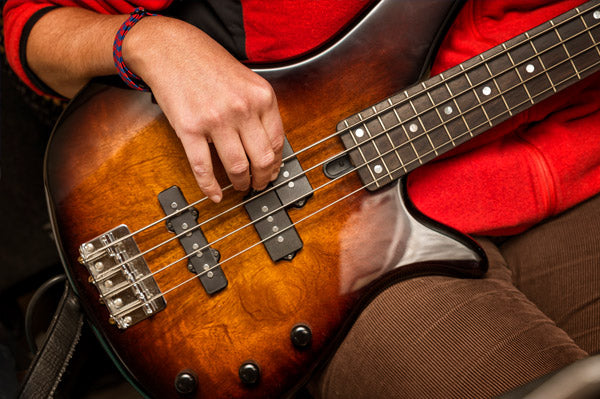
This type of pickup actually consists of two individual pickups housed separately and offset from one another.
Split coil pickups utilize a shorter, wider coil and as a result produce a warmer, thicker sound, emphasizing the mid and low frequencies.
MM Style Pickups
MM style pickups take their name from Music Man© bass guitars and feature more of a traditional humbucker design rather than on offset split coil design. You will see this style of pickup on the appropriately named ‘MM Bass Guitar Kit’
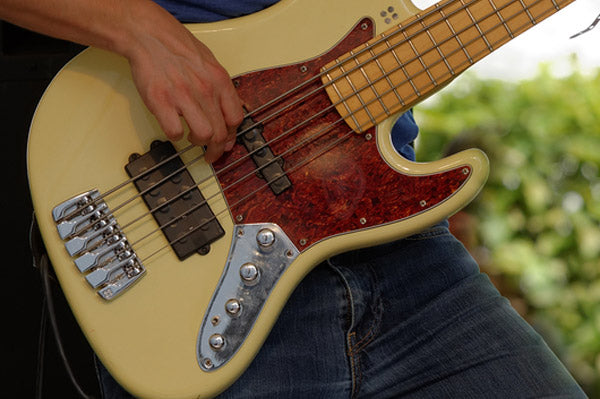
The pole pieces are typically wider than what you might expect to see on a J or P bass pickup and this additional magnet size produces greater note articulation, especially in the lower end making them ideal for the bass guitar and genres such as rock and funk.
Summary
While pickups are a fascinating subject for many of us and play a large role in how our guitars sound, tone as it often stated is mostly in the fingers.
Consider guitarists such as Keith Richard's or Angus Young. I think most of us would agree, regardless of the guitar being played they are likely to sound much the same due to the inherent feel of their playing and aspects such as vibrato and note selection.


